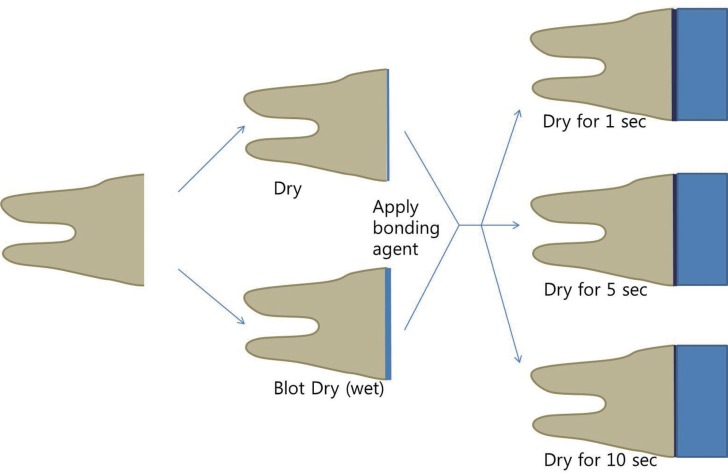Restor Dent Endod.
2012 Aug;37(3):155-159. 10.5395/rde.2012.37.3.155.
Effect of moisture and drying time on the bond strength of the one-step self-etching adhesive system
- Affiliations
-
- 1Department of Conservative Dentistry, Yonsei University Wonju College of Medicine, Wonju, Korea.
- 2Department of Conservative Dentistry, Yonsei University College of Dentistry, Seoul, Korea. pjw@yuhs.ac
- KMID: 1995655
- DOI: http://doi.org/10.5395/rde.2012.37.3.155
Abstract
OBJECTIVES
To investigate the effect of dentin moisture degree and air-drying time on dentin-bond strength of two different one-step self-etching adhesive systems.
MATERIALS AND METHODS
Twenty-four human third molars were used for microtensile bond strength testing of G-Bond and Clearfil S3 Bond. The dentin surface was either blot-dried or air-dried before applying these adhesive agents. After application of the adhesive agent, three different air drying times were evaluated: 1, 5, and 10 sec. Composite resin was build up to 4 mm thickness and light cured for 40 sec with 2 separate layers. Then the tooth was sectioned and trimmed to measure the microtensile bond strength using a universal testing machine. The measured bond strengths were analyzed with three-way ANOVA and regression analysis was done (p = 0.05).
RESULTS
All three factors, materials, dentin wetness and air drying time, showed significant effect on the microtensile bond strength. Clearfil S3 Bond, dry dentin surface and 10 sec air drying time showed higher bond strength.
CONCLUSIONS
Within the limitation of this experiment, air drying time after the application of the one-step self-etching adhesive agent was the most significant factor affecting the bond strength, followed by the material difference and dentin moisture before applying the adhesive agent.
Keyword
MeSH Terms
Figure
Cited by 1 articles
-
Effect of different air-drying time on the microleakage of single-step self-etch adhesives
Horieh Moosavi, Maryam Forghani, Esmatsadat Managhebi
Restor Dent Endod. 2013;38(2):73-78. doi: 10.5395/rde.2013.38.2.73.
Reference
-
1. Frankenberger R, Krämer N, Petschelt A. Technique sensitivity of dentin bonding: effect of application mistakes on bond strength and marginal adaptation. Oper Dent. 2000; 25:324–330. PMID: 11203838.2. Soderholm KJ, Soares F, Argumosa M, Loveland C, Bimstein E, Guelmann M. Shear bond strength of one etch-and-rinse and five self-etching dental adhesives when used by six operators. Acta Odontol Scand. 2008; 66:243–249. PMID: 18615325.3. Perdigão J. New developments in dental adhesion. Dent Clin North Am. 2007; 51:333–357. PMID: 17532916.
Article4. Van Landuyt KL, Mine A, De Munck J, Jaecques S, Peumans M, Lambrechts P, Van Meerbeek B. Are one-step adhesives easier to use and better performing? Multifactorial assessment of contemporary one-step self-etching adhesives. J Adhes Dent. 2009; 11:175–190. PMID: 19603581.5. Van Meerbeek B, De Munck J, Yoshida Y, Inoue S, Vargas M, Vijay P, Van Landuyt K, Lambrechts P, Vanherle G. Buonocore memorial lecture. Adhesion to enamel and dentin: current status and future challenges. Oper Dent. 2003; 28:215–235. PMID: 12760693.6. Yiu CK, Hiraishi N, King NM, Tay FR. Effect of dentinal surface preparation on bond strength of self-etching adhesives. J Adhes Dent. 2008; 10:173–182. PMID: 18652265.7. Kitayama S, Nikaido T, Ikeda M, Foxton RM, Tagami J. Enamel bonding of self-etch and phosphoric acid-etch orthodontic adhesive systems. Dent Mater J. 2007; 26:135–143. PMID: 17410904.
Article8. Chiba Y, Rikuta A, Yasuda G, Yamamoto A, Takamizawa T, Kurokawa H, Ando S, Miyazaki M. Influence of moisture conditions on dentin bond strength of single-step self-etch adhesive systems. J Oral Sci. 2006; 48:131–137. PMID: 17023745.
Article9. Di Hipólito V, de Goes MF, Carrilho MR, Chan DC, Daronch M, Sinhoreti MA. SEM evaluation of contemporary self-etching primers applied to ground and unground enamel. J Adhes Dent. 2005; 7:203–211. PMID: 16240961.10. Jin MU, Kim YK, Park JW. The influence of moisture control on bond strength of composite resin treated with self-etching adhesive system. J Korean Acad Conserv Dent. 2002; 27:363–369.
Article11. Werner JF, Tani C. Effect of relative humidity on bond strength of self-etching adhesives to dentin. J Adhes Dent. 2002; 4:277–282. PMID: 12666747.12. Nakaoki Y, Sasakawa W, Horiuchi S, Nagano F, Ikeda T, Tanaka T, Inoue S, Uno S, Sano H, Sidhu SK. Effect of double-application of all-in-one adhesives on dentin bonding. J Dent. 2005; 33:765–772. PMID: 16199285.
Article13. Jacobsen T, Finger WJ, Kanehira M. Air-drying time of self-etching adhesives vs adhesive efficacy. J Adhes Dent. 2006; 8:387–392. PMID: 17243596.14. Chiba Y, Yamaguchi K, Miyazaki M, Tsubota K, Takamizawa T, Moore BK. Effect of air-drying time of single-application self-etch adhesives on dentin bond strength. Oper Dent. 2006; 31:233–239. PMID: 16827027.
Article15. Van Landuyt KL, Snauwaert J, De Munck J, Coutinho E, Poitevin A, Yoshida Y, Suzuki K, Lambrechts P, Van Meerbeek B. Origin of interfacial droplets with one-step adhesives. J Dent Res. 2007; 86:739–744. PMID: 17652202.
Article16. Hiraishi N, Breschi L, Prati C, Ferrari M, Tagami J, King NM. Technique sensitivity associated with air-drying of HEMA-free, single-bottle, one-step self-etch adhesives. Dent Mater. 2007; 23:498–505. PMID: 16690113.
Article17. Van Landuyt KL, Snauwaert J, Peumans M, De Munck J, Lambrechts P, Van Meerbeek B. The role of HEMA in one-step self-etch adhesives. Dent Mater. 2008; 24:1412–1419. PMID: 18433860.
Article18. Tay FR, Gwinnett JA, Wei SH. Micromorphological spectrum from overdrying to overwetting acid-conditioned dentin in water-free acetone-based, single-bottle primer/adhesives. Dent Mater. 1996; 12:236–244. PMID: 9002841.
Article19. Tsuchimoto Y, Yoshida Y, Mine A, Nakamura M, Nishiyama N, Van Meerbeek B, Suzuki K, Kuboki T. Effect of 4-MET- and 10-MDP-based primers on resin adhesive to titanium. Dent Mater J. 2006; 25:120–124. PMID: 16706306.
- Full Text Links
- Actions
-
Cited
- CITED
-
- Close
- Share
- Similar articles
-
- Effect of Saliva Decontamination on Bond Strength of 1-step Self-etching Adhesives to Dentin of Primary Posterior Teeth
- The effect of saliva decontamination procedures on dentin bond strength after universal adhesive curing
- Microtensile bond strength of silorane-based composite specific adhesive system using different bonding strategies
- Evaluation of Shear Bond Strength of Various Orthodontic Bracket Bonding Agents
- Influence of Application Method on Shear Bond Strength and Microleakage of Newly Developed 8th Generation Adhesive in Primary Teeth


